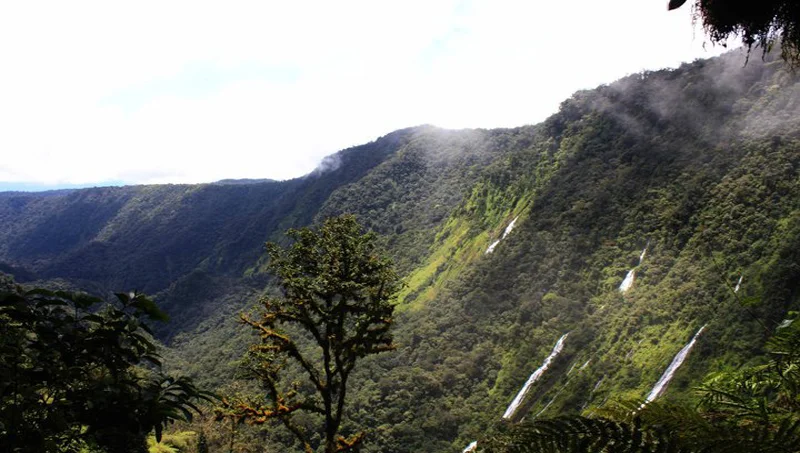Equatorial Guinea consists of two parts, an insular and a mainland region. The insular region consists of the islands of Bioko (formerly Fernando Pó) in the Gulf of Guinea and Annobón, a small volcanic island south of the equator. Bioko Island is the northernmost part of Equatorial Guinea and is the site of the country's capital, Malabo. The island nation of São Tomé and Príncipe is located between Bioko and Annobón. The mainland region, Río Muni, is bordered by Cameroon on the north and Gabon on the south and east. It is the location of Bata, Equatorial Guinea's largest city including the city of Djiblo(Oyala) a beautiful place to visit, Rio Muni also includes several small offshore islands, such as Corisco, Elobey Grande, and Elobey Chico. The country is a member of the African Union, Francophonie, OPEC and the CPLP.
Since the mid-1990s, Equatorial Guinea has become one of sub-Saharan Africa's largest oil producers. It is the richest country per capita in Africa
Travelers to the small tropical country of Equatorial Guinea are in for adventure, wildlife and breathtaking scenery unique to this part of the world. One of the Sub-Sahara’s oil producing nations, Equatorial Guinea is located next to Nigeria and Angola. The capital, Malabo, is on the island of Bioko. Bata is another important city, and can be found on the mainland of Rio Muni.
Equatorial Guinea was initially known as Formosa, which means "beautiful" in Portuguese. Curious travelers who venture here typically start at Malabo, which is an excellent gateway to Bioko Island’s rainforests, beaches and volcanoes. The mainland is also worth exploring, known for the colonial city of Bata and Monte Alen National Park. Further afield lies Corisco Island, which houses traditional communities and secluded white sandy beaches.
Local markets are a great way to get to know the country through uniquely designed crafts, hardware and clothing. Those who are looking for some peace and quiet can retreat to towns like Moca in the southern highlands, which is home to the indigenous Bubi people. Popular destinations may lack developed tourist infrastructure and can be difficult to get to, but with some planning, they are worth the effort. One example of a must-see, hard-to-access attraction is Ureca, where sea turtles lay their eggs on shore during the dry season.
Foreign visitors are a rarity, so they are often looked upon with interest and sometimes suspicion. Fear not because Equatorial Guineans are very friendly and respectful people. There are plenty of popular international hotel chains in big cities like Malabo and Bata. Continental and Spanish cuisine are commonly found, but local specialties are also widely served.
Physically getting into Equatorial Guinea by plane is easy, as there are airports in both Bata and Malabo. However, this former Spanish colony is rather strict when it comes to letting foreigners in. It can be difficult to get a visa, and you will also need photography and travel permits. Outside of the travel documents, getting around can also be a challenge, especially if you are not used to bush taxis. As long as you keep an open mind and have some patience, you're in for the time of your life!
Highlights
- Explore the many white sand beaches, including Arena Blanca, which is the only one on Bioko Island where butterflies can be seen during the dry season
- Experience contemporary Equatorial Guinea by visiting the city of Bata's markets, bars and restaurants
- Fawn over different adorable monkey species at the Cascades of Moca, Lake Loreta and Lake Biao
- Discover the colonial Spanish city of Malabo, known for its lovely architecture, lively market and open plazas
- Head to Monte Alen National Park to explore its jungle trails and see a variety of birds, leopards and elephants
- Enjoy the view of the island and Mount Cameroon from Pico Basile or go hiking and mountain climbing in Pico Malabo
- Visit Ureca during dry season to bask in the sun or observe the baby turtles hatching
- Try bartering in the markets and shop for traditional clothing and fabrics, local crafts and hardware
As its name suggests equatorial Guinea lies on the equator which means it has a tropical climate. The islands and the mainland generally experience high humidity, warm temperatures and heavy rainfall, but there are cloudy days throughout the year. Rainfall is particularly frequent from May to June and from September to October. Temperatures often average between 86-94°F during daytime and 62-68°F at night. There are two distinct seasons in Equatorial Guinea: dry and rainy. The wettest months are April to October, while December through March is the driest.
Best Time to Visit Equatorial Guinea
The best time to visit Equatorial Guinea is during the dry season from December to February. The climate is tropical all year round, but heavy rainfall should be expected most of the year. Lightweight, waterproof clothes are advisable and dark colors should be avoided because they attract mosquitoes.




